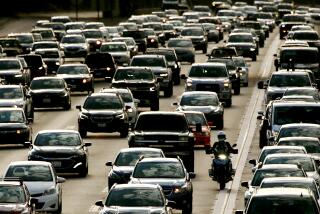County’s Smog Level Dips for 1st Time in 2 Years : Environment: Decrease in pollution transported by the wind from Los Angeles is cited as a major factor.
Smog levels in San Diego County decreased in 1990 for the first time in two years primarily because of wind conditions and a decrease in Los Angeles’ air pollution, according to an annual air quality report card released Wednesday.
The yearly analysis, conducted by the San Diego County Air Pollution Control District, attributed the improvement to a reduction in “transport smog” carried from Los Angeles to San Diego, especially during Santa Ana winds.
“Los Angeles had the cleanest air in its (recent) history and consequently less pollution was transported to San Diego,” said R. J. Sommerville, the county’s air pollution control officer.
The report showed that San Diego County violated federal pollution health standards 39 days in 1990, down from 55 days in 1989.
In addition, Stage I smog alerts--a condition of pollution that requires officials to advise the elderly and those with respiratory or cardiac problems to limit their physical activity--was down to one day from two in 1989, Sommerville said.
Transport smog has always played a significant role in San Diego’s air pollution levels and accounted for about two-thirds of the days in which the county violated federal health standards in 1990, Sommerville said.
“The highest and most intense levels of smog experienced in San Diego are primarily caused by transport from L.A.,” he said. “But that doesn’t mean we don’t have our own problems we need to clean up.”
Over the years, there have been fewer and fewer days when transported smog has exceeded the federal standard so “there has been an improvement,” Sommerville said.
Industry accounts for about 20% of the county’s air pollution, while cars and trucks account for about 60%, Sommerville said.
Under the California Clean Air Act of 1988, the district by June 1 must submit a strategy that will reduce vehicle use and traffic congestion to the California Air Resources Board.
The board requires areas with severe smog problems such as San Diego to reduce smog-producing pollutants by 5% a year. The San Diego district will draft regulations for public comment next month, before presenting a plan to the board by June 1, Sommerville said.
Central to the district’s plan are proposals designed to increase the number of public buses and improve the trolley system, as well as incentives for employers to make car and van pools easier. The plan also calls for employers to provide subsidies for workers who purchase monthly bus passes.
Although technological improvements on automobiles have helped curtail air pollution, only a change in motorists’ habits will help keep the county within new state air pollution standards, Sommerville said.
“The number of (automobile) trips in the region are increasing about twice the number of the rate of growth,” he said. “Unless that is dealt with, we will start to lose our progress made through technology.”
More to Read
Sign up for Essential California
The most important California stories and recommendations in your inbox every morning.
You may occasionally receive promotional content from the Los Angeles Times.










